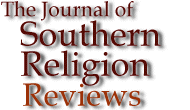

Larry G. Murphy, ed., Down by the Riverside: Readings in African American Religion. New York: NYU Press, 2000.
African American religious practices and institutions have been the focus of many different religious studies scholars and laypersons since the early twentieth century. Most of their attentions have been devoted to studying various Christian denominations, with fewer sources carefully documenting the rites and history of African American Muslims, Jews, agnostics, and atheists. Such studies may be found in individual books, book chapters, or journal articles devoted to various groups, but the student of African American religion would be hard-pressed to find a single text that provides a thorough survey of the broad spectrum of African American religious practices from slavery until the present. In Down by the Riverside: Readings in African American Religion, Larry G. Murphy has provided such a text for both the scholar/instructor and the beginning college student. Murphy's editorial policy is inclusive, without being unwieldy or diffuse. Murphy's text seeks to understand African Americans as a whole via their religious practices, arguing that the black spiritual cosmos is central to every political and cultural moment within African American history. Murphy begins with essays by such luminaries as Charles H. Long, C. Eric Lincoln, Albert J. Raboteau, and others who delineate the problems that come with defining African American religion. Long indicates, for instance, that the methods of the social sciences have frequently been applied in studies of African Americans' religions, but until the 1960s, the complexities of black theology had been all but ignored.
In many ways, all of the essays in Down by the Riverside draw upon Long's basic argument. Each offers proof that the structure of black theology is inextricably linked to black history. As African Americans redefined their identities, both collectively and individually, by class, region, and color caste, so did new denominations and sects arise, each with its own theology, but bound by a shifting, complex sense of group identity.
|
|
|
| "The collection's greatest strength is Murphy's willingness to include interpretations from myriad sources, from independent laypersons and scholars to the most respected current and past leaders in religious studies." | |
|
|
The collection's greatest strength is Murphy's willingness to include interpretations from myriad sources, from independent laypersons and scholars to the most respected current and past leaders in religious studies. Thus Murphy includes a vignette documenting the existence of an Afro-Monrovian community in North Carolina, an Afrocentric reading of black religious history by Maulana Karenga, and entire sections devoted to little known, and occasionally controversial, religions, denominations, and sects. After reading such essays as Richard Brent Turner's history of the African Muslim presence in colonial and antebellum slavery, Anthony Pinn's studies of black humanism and Orisha worship, and the numerous histories of Catholicism and church-based activism, African American religions overwhelmingly appear as diverse as the people themselves. Moreover, in the section on black and womanist theologies, Murphy also includes a generous number of essays that focus upon the essential roles that women have played in developing African American theologies and religion-based activism, to say nothing of the many essays scattered throughout the anthology that seamlessly incorporate close analyses of gender issues.
No collection with Down by the Riverside's ambitions is without a few shortcomings, of course, and some deserve brief mention here, if only for the sake of constructive criticism. Inevitably, some sources become redundant as they cover the same subject areas. Murphy avoids this for the vast majority of the text by virtue of his commitment to diverse viewpoints, and attempts to choose excerpts that introduce new angles in each subject area, but is not always successful. The first half-dozen essays illustrate this situation, and could wear on the patience of the beginning, or otherwise skeptical student. Again, though, this situation is particularly difficult to avoid in a book that must place most of its attention on African American Christianity by default. It is also strange to see relatively little attention devoted to the Nation of Islam, whose role in African American communities as both a religious institution and a political force is undeniable. While Turner's and Gordon Melton's essays are excellent introductions to the subject, the very inclusion of Nation of Islam expert C. Eric Lincoln's work four times in the volume makes the absence of material from Lincoln's The Black Muslims in America, inarguably the first authoritative study of the group, rather stark.
These minor concerns aside, though, any instructor of African American religious practices and theology would be well advised to assign this text. As is true of Winston Napier's African American Literary Theory: A Reader, also published by NYU Press, the variety of thoughtful studies in its pages obviates the need for many instructors to photocopy vast numbers of essays for their classes. Most important, though, the text effectively ensures that no reader could ever speak of "the Black Church" as a monolith again, or otherwise declare African American religious practices irrelevant or marginal to an understanding of African American communities.
Darryl Dickson-Carr, Florida State University
© 2001 by The Journal of Southern Religion.
All rights reserved. ISSN 1094-5234